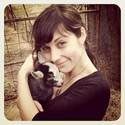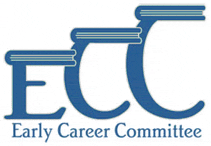
Colleen A.F. Venable, Designer, First Second Books | September 24, 2012

COLLEEN A.F. VENABLE, designer, First Second Books
Your first job in publishing was at the Children’s Book Council. How did you come to the CBC and children’s publishing?
I graduated college in 2002, winning the award “Biggest Book Dork.” Some might call it Valedictorian, but I think biggest book dork is more appropriate. Four years of reading books and saying what I think about them?! SO EASY! I had a double major of English and Studio Art with the sole purpose of getting into children’s publishing and assumed the world outside would be as easy as I found college. I’d land a job within weeks…no hours…I’d land a job a semester BEFORE graduating-companies fighting over that girl that could write eight page critiques in a single hour with less than three hours of sleep!
But, like so many people find out in their early 20’s, the real world wasn’t quite what I expected. 2002 was a rough year to be in NYC and jobs were scarce. I sent out over 300 resumes and cover letters, and got ZERO calls. For months I lived off of credit card cash advances, ate nothing but sliced cheese, and scoured the print edition of the NY Times applying to every single job that said Entry-Level no matter how painful it sounded.
It was there that I saw a job for “Receptionist/Librarian for The Children’s Book Council.” It sounded perfect. Beyond perfect. A chance to work with ALL of the kids publishers and see every single thing they published. I desperately wanted the job. I broke every rule they teach you about cover letters and instead sent a short story about how much kids books mean to me and the reasons why you should never tell people in cocktail parties that Roald Dahl’s THE TWITS is your favorite book. I faxed (yes FAXED, if you are in your 20’s go watch BACK TO THE FUTURE 2 to see what I’m talking about) my resume along with hundreds of other applicants. My odd letter stood out, and I was hired by the amazing Paula Quint and Molly Ker Hawn, two geniuses who had enough brain power to light up the eastern coast. They were passionate about books and invaluable as mentors.
As a founding member of the Early Career Committee, what inspired the creation of the ECC? What were its original goals/intentions?
CBC always had wonderful committees where publishing staff work directly with librarians and booksellers and teachers, but all of the members of these committees were Editorial Directors, Art Directors, Publishers…all higher level staff. Molly Ker Hawn wanted a way to get the younger staff involved. She came up with the idea of the ECC and gave it to me to run with it.
Whenever we had our bigger meetings the younger staff would huddle together in clumps by company, never intermingling with other houses. One of our goals was to help people in their first years years of publishing get to know each other and to thrive on collaboration and friendships, making the future of the industry brighter. We wanted to build a community who shared the common love of children’s and YA books. We started series of lectures, a book club, Boldface the newsletter, many other one-off events, and my own personal favorite, The Extreme Trivia Challenge. Book people grew up watching others around us collect trophies-for running, for swimming, for doing some weird throwing thing with a giant orange ball and a netted hoop or something. It was rare for a book person to have a chance at a trophy and as a total trivia addict I thought it would be fun to see just how much we all knew about children’s books. After one phone call to a trophy maker in which I asked “Do you have trophy toppers for ‘fattest bunny’ or something?” the Trivia Challenge and Golden Bunnies were born.
What were the ECC’s greatest challenges at its outset?
Attendance was difficult. Our original committee was four people from four different houses, and try as we might most of our events wound up being other young staff from those houses who had been dragged out of their offices-likely attending only as a favor to their colleague. It took a while before ECC events started to feel less like work and more like the community we were trying to build. I love how big the committee is now, with members from so many houses, and I love how widely attended the events are. Also I must say, you have some stellar design on those event invites!
Any funny, surprising or triumphant ECC-related anecdotes that you want to share?
I became very close friends with those first committee members and I’ve remained close with them ever since. Two members in particular, Martha Mihalick and Molly O’Neill, have supported me, helped guide me, and made me laugh for nearly 10 years now. They were there when I submitted my first manuscript to a publisher…and my third…and fourth…and when I finally sold the idea for GUINEA PIG PET SHOP PRIVATE EYE, it was no coincidence that the two bunnies always eating books are named Martha and Molly. It’s becoming a common thing with the ECC. You aren’t just “networking.” You’re making friends for life.
Is there anything that you learned from being an ECC member that applies to your career today?
I learned that you should never be afraid to meet new people. Be that person who will walk around a party and say hello to everyone. And if you want to lead a happy life, surround yourself with amazing people.
How did you make the jump from the CBC to your current job as a designer for First/Second Books?
Lauren Wohl was one of the higher-level people I had the pleasure of working with at the CBC. I had been at the council for 5 years, which in publishing years is probably equivalent to 25. She offered me a role in marketing at Roaring Brook Press. She was another of my early mentors, and again incredibly intelligent and brilliant with people. I happily took the job, and while I loved working with Lauren and conventions, I started to get more into design, learning photoshop and creating all of Roaring Brook’s advertising during those years. My cubicle was right next to Mark Siegel’s office, First Second’s Editorial Director, who happened to be looking for a designer. He offered me the job, and Macmillan paid for me to go back to night school to learn InDesign-a program I had never one used but is 90% of my job. It was a rough learning curve, but years later now, I am so thankful to Lauren and Mark for taking a chance on me.
What skills do you think are indispensable to working in design?
Reading other books. Not just LOOKING at the covers to other books. Great covers are only truly great if they convey the heart of the story inside. I’m always confused by designers who don’t read. I have a rule that I read books twice before I even start to brainstorm covers. Being a good book designer isn’t the same thing as being a good designer.
Also: patience and strong verbal skills (You probably didn’t guess that second one, right?). For every single book I go through all of our house fonts (20,000+) even when I have an idea of a font in the beginning. I try not to reuse fonts, and make hand-drawn logos when possible. It’s so easy to get stagnant and to fall into a pattern, because this is a hard demanding job. It’s also easy to follow the crowd and make books “that will sell” with covers that look like all the others on the shelf. Don’t be afraid to be a leader and try something new, but also learn how to be eloquent with your thoughts. If you can’t explain why you believe in your work, you’re going to have a rough future of sales meetings. I think the biggest thing though is to stand up for your designs, but to not get an ego. Collaboration can actually lead to some amazing covers if you’re receptive to ideas.
How does the design process differ working in graphic novels than in other areas of children’s books?
Shhhh don’t tell our sales team this, but I honestly think I have an easier time getting oddball covers approved. Our sales team is great and understands that we really know the graphic novel market and many times will back down and let us do what we think is right for a book and the genre.
The other big difference is the time-intensive interior designs. Imagine if every single copyedit had to be made by hand…in photoshop. Correcting hand-lettered books is insanely time consuming. Add that to the actual piecing together of line-art/color/text layers, color correcting, fixing balloons, lettering, separating text from the words for foreign editions: times 200 pages. A design friend who freelanced a single graphic novel recently told me I was insane for doing it as my day job.
What is the best piece of advice you ever received?
A friend once told me to “work like a shark swims,” which I took to mean always moving forward, never stopping to worry about what might happen, or dwelling on past regret. Also, grow an extra set of teeth.
What is your favorite typeface?
It depends on the day. I was recently obsessed with Royal Oak Sans by a German studio named “Die Typonauten” (which I like to believe is German for “DIE TYPOS!!!”…um…yeah I don’t speak any German.) But my favorite font designer is John Martz, a great artist and cartoonist who’s been the secret weapon behind my sanity. John has made nearly a dozen fonts from our creator’s handwriting fonts with randomizing letters so they appear natural. Creators from Sara Varon to Paul Pope have all had fonts made by John.
Do you have any favorite design blogs, or other sources of visual inspiration?
I really love:
That Cover Girl blog: http://thatcovergirl.com/
The Book Cover Archive: http://bookcoverarchive.com/
Book By Its Cover: http://www.book-by-its-cover.com/
I also religiously read Shelf Awareness, American Libraries, PW Children’s Bookshelf, the Horn Book, Kirkus, and MyFonts newsletters.
Recent years have seen a rise in picture-book biographies. Were your life ever to be chronicled in such a way-and don’t be modest, now-who would you choose to illustrate it?
I’m assuming this is so far away that time travel and/or the ability to raise people from the dead will be options so I’d choose Jon Stone to write it-he wrote my favorite picture book of all time THE MONSTER AT THE END OF THIS BOOK and would write me as the Muppet I truly am. And have James Marshall draw it. That said, if I had to stick to the land of the living Laurie Keller is my absolute favorite and I’d be honored if she recreated my life. Especially if she did it with me drawn as a donut.







